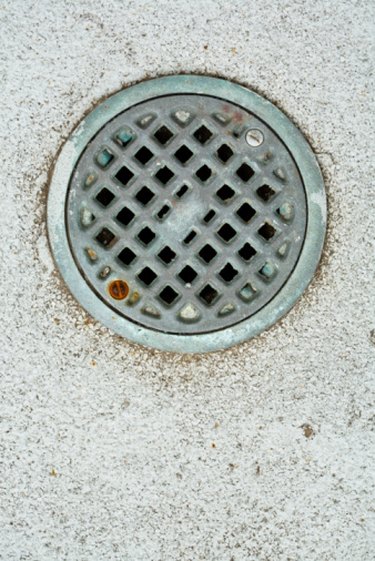Things You'll Need
Foundation repair foam
Plumber’s snake
Sump pump
Silicate-based penetrating sealer

If the concrete floor of your basement is always wet, there may be a number of causes. Most of these causes involve the water table outside your home, which is the level where water stands at all times. The water table is higher during rainy periods and lower during dry spells. If the basement drains don't allow for an overly high water table, you may have water seeping through the concrete walls and floor. If you don't provide adequate concrete pressure relief, the concrete floor may crack or even buckle.
Step 1
Repair any loose guttering and downspouts. Make sure the downspouts carry the water at least 10 feet away from the house. Watch the gutters during a heavy rain. If they can't handle the water runoff, add another downspout.
Video of the Day
Step 2
Walk around the home's exterior. Look for low places that may allow water to enter into your home. Fill in low areas with clay dirt, which causes the water to run away from the house rather than absorbing it. Also examine the driveway and sidewalks to make sure they're diverting water away from the house.
Step 3
Fix any exterior cracks in the foundation. Inject foundation repair foam into the cracks to seal them.
Step 4
Clean the basement drains. Use a plumber's snake to make sure the drains are operating properly. If exterior--or French--drains exist outside the house, hire a contractor to clean them out, or rent the equipment and do it yourself. Remove shrubs and trees that may grow into the French drains and clog them.
Step 5
Compare the costs of adding outside French drains versus indoor drains. If you install the drains outdoors, you must go as deep as the footings, usually 6 to 9 feet deep. To install them indoors, cut out a portion of your basement's concrete floor to install the drains below the floor level. Since either job may be a difficult do-it-yourself project, you may want to hire a contractor to do the job.
Step 6
Add a sump pump to help remove water from the drains and to provide concrete pressure relief. In some instances the drains work and the water doesn't have any place to go. Sump pumps remove that problem.
Step 7
Coat the walls and floor of the concrete basement with silicate-based penetrating sealer. Concrete is porous and this product soaks into the pores and seals concrete, providing a waterproof barrier.
Video of the Day